Sd.Kfz.250 / 9 combat reconnaissance vehicle (Germany)
By the time of the attack on the Soviet Union, the main combat vehicle of Nazi German intelligence officers was the Sd.Kfz.222 armored car. This machine was in service with the 1937 year and until a certain time suited the army. However, over time, it was decided to replace this technique with more advanced samples. The fighting on the Eastern Front showed that wheeled armored vehicles are not always able to fully solve the tasks assigned in off-road conditions, as well as in difficult conditions of autumn and winter in the territory of the USSR. Available armored cars required some kind of replacement.
Variants of modernization of the existing machine and the development of a completely new project of such equipment were immediately rejected. The situation did not allow to engage in such work for technical and economic reasons. In addition, there were financial constraints. The only real way out of this situation was the development of a combat reconnaissance vehicle based on one of the existing models of equipment with acceptable characteristics.
The Sd.Kfz.250 armored personnel carrier found a promising and promising basis for the new reconnaissance vehicle. This equipment was already produced in large quantities and was actively used by the troops, which could facilitate the deployment of the assembly of new specialized machines, as well as simplify their operation. In addition, the BTR of the existing model met the requirements for mobility in rough terrain. Thus, the reconnaissance vehicle should be built on the basis of the existing serial equipment.
The new project received the designation leichter Schützenpanzerwagen 2 cm and Sd.Kfz.250 / 9. In addition, the name Gerät 883 was used. The main designations of the project reflected the serial number of the development, as well as the class, purpose and used weapon. As the name implies, a light reconnaissance vehicle with an 20-mm gun was created.
To reduce the time required to develop the project and prepare for mass production, it was decided to abandon the creation of a large number of new components and assemblies. It was proposed to minimally modify the housing of the existing chassis, and then install on it the existing combat module with weapons. This made it possible to solve a number of design and technological problems, and also in the shortest possible time to establish the serial construction of reconnaissance vehicles.
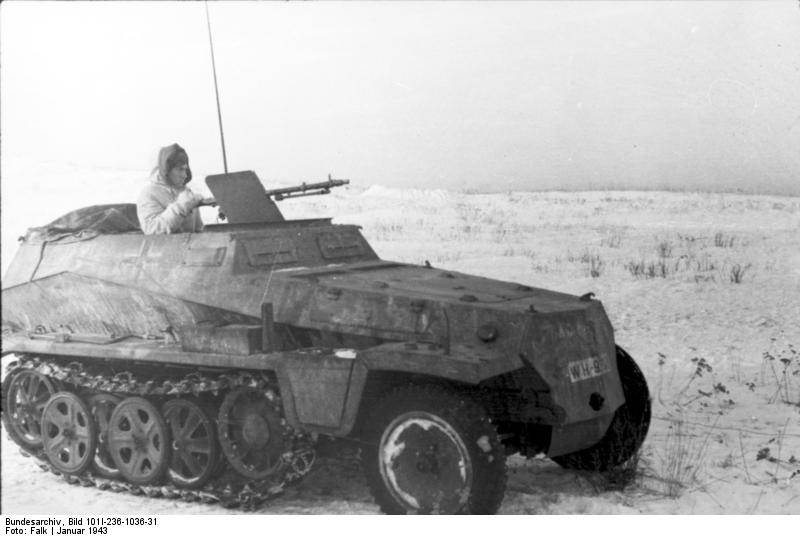
Armored personnel carrier Sd.Kfz.250 Alte. Photo of Wikimedia Commons
Initially, the base for the Sd.Kfz.250 / 9 vehicle was to be a basic version of an armored personnel carrier, which from the 1943 of the year was designated as Alte (“Old”). Then a new modification of the armored car went into the series, which was distinguished by the hull design, powerplant, etc. By changing the body with a reduction in the number of parts from 19 to 9, it was possible to slightly simplify the design, as well as to simplify the manufacture of the technique, called the Neu (“New”). Both versions of the armored personnel carrier were later used in the construction of reconnaissance vehicles.
The Sd.Kfz.250 Alte armored personnel carrier was equipped with an armored body of recognizable shape, consisting of a relatively large number of sheets of different shapes and sizes. The corps provided anti-bullet protection and was divided into two main compartments. In its front part, which had a smaller height, fit the engine compartment. Behind him there was a manned compartment in which all the places for the crew and the landing were located.
The case had front sheets 10-14,5 mm thick, located at different angles to the vertical. Two frontal sheets of small size formed a wedge-shaped front wall of the engine compartment, behind which there was an inclined roof. Behind the roof was provided frontal sheet of small height with viewing devices. 8-mm boards differed unusual design. The upper part of the sides of the engine compartment went into the protection of the habitable compartment. As a result, the sides of the middle and rear parts of the hull had a characteristic shape with the bottom sheets sprawled outward and the top set tilted inwards. Behind the hull was covered with a stern sheet 8 mm thick, in which there was a door for access to the car.
As part of the Sd.Kfz.250 Neu project, it was decided to abandon the complex structure of the hull, reducing the number of armor plates needed. The engine compartment at the front and on top was covered with even sheets of the desired shape, and the complex sides of the hull were transformed into a design with fenced niches, ducts and inclined upper sheets. The design of the stern and bottom remained unchanged.
The “old” armored personnel carrier was equipped with a Maybach HL 42TRKM carburetor engine with 99 horsepower. Through a mechanical transmission with seven forward gears and three rear torque transmitted to the drive wheels caterpillars. In the course of the “New” modernization, the armored vehicle received a Maybach HL 42TUKRM engine with similar power ratings. Transmission remained without significant changes.
The chassis of the two variants of the armored personnel carrier was the same. In front of the hull there was a single wheelbridge. It was equipped with leaf springs and was made manageable. It was proposed to maneuver by turning the wheels, which greatly simplified the design of the transmission. A tracked propulsion unit was placed under the central and aft parts of the hull. He received four road wheels of a chess arrangement with an individual torsion bar on each side. The driving wheels were installed in front of the rollers and guides in the stern. Due to the large diameter of the rollers, the running gear did not need support rollers.
In the basic version of the BTR Sd.Kfz.250 was controlled by a crew of two people and could carry four paratroopers. Access to the car was carried out using the stern door and through the side due to the lack of a roof. There was a set of viewing instruments in front of the habitable compartment. Armament consisted of one or two rifle caliber machine guns. The front machine gun was equipped with an anti-rolls, aft mounted on an open pivot installation.
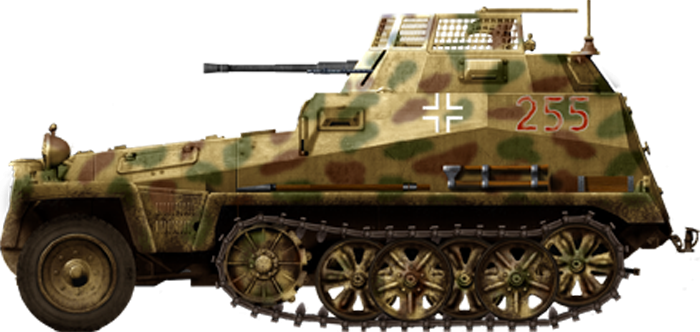
Reconstruction of the appearance of the BRM Sd.Kfz.250 / 9 chassis Alte. Figure Tanks-encyclopedia.com
The Sd.Kfz.250 / 9 project proposed to subject the body of an armored personnel carrier to minor modifications, as a result of which the vehicle could become the carrier of a new combat compartment with higher power weapons. To do this, the body should be closed at the top, installing an armored roof. In the sheet of the roof, in its central wide part, there was a shoulder strap for installing the tower. In connection with the installation of the roof of the car was deprived of funds for the installation of machine guns and the front armor shield.
During operation on the Eastern Front, it was found that the Sd.Kfz.222 armored cars do not meet the requirements for mobility, but at the same time they have satisfactory firepower. This fact was taken into account when developing the design of the reconnaissance vehicle Sd.Kfz.250 / 9. It was decided to borrow a ready-made turret with a full set of weapons, sighting equipment, etc. from the existing armored vehicles. Using this approach, we were able to significantly speed up the development of the project and get rid of the need to deploy the production of new products.
The Sd.Kfz.222 armored tower was a unit of ten-sided shape, consisting of sheets 8 mm thick. The front and aft parts of the tower had a wedge-shaped shape, the sides were parallel to the longitudinal axis of the product. Between the frontal assemblies and the side sheets there were smaller cheek sheets. The roof of the tower project was not provided. At the same time, the fighting compartment was covered with a double-frame construction in the form of frames with a grid. Using this device, it was proposed to protect the fighting compartment from possible hits of hand grenades.
In the center of the frontal part of the tower there was a slot for the trunk of the main gun. To her right there was a smaller slot for the sight, to the left for the machine gun. The main weapon of the Sd.Kfz.222 armored car and, as a result, the Sd.Kfz.250 / 9 combat reconnaissance vehicle was supposed to be the 30 mm KwK 20 automatic cannon. A rifled gun with a barrel length 55 caliber could fire at a rate of up to 280 shots per minute. Provided acceleration of the projectile to speed 780 m / s. Additional armament consisted of a single MG 34 machine gun coupled to a cannon.
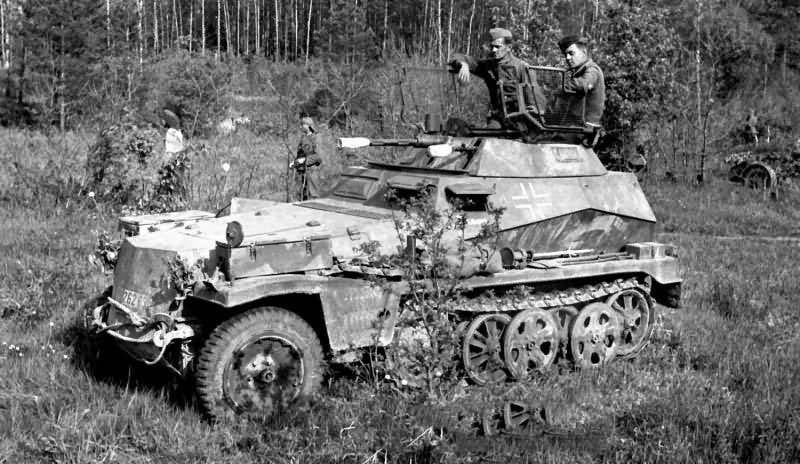
Intelligence machine at the front. Photo Worldwarphotos.info
The armament mounting system was equipped with manual pointing drives and allowed firing in various directions. Circular guidance was provided in a horizontal plane, carried out by turning the entire tower. Elevation angles varied from -10 ° to + 80 °, which allowed attacking both ground and air targets. Depending on the situation, the gunner could synchronize the descent of the gun and the machine gun or use them separately. The ammunition consisted of 180 shells for guns and 2000 cartridges for machine guns. According to other data, in the course of adaptation to the new base machine, the gun ammunition was reduced to 100 shells in 10 stores.
Interestingly, the use of the finished tower with a large range of angles of vertical guidance led to some confusion. Because of this feature, in a number of sources the reconnaissance vehicle Sd.Kfz.250 / 9 is referred to as an anti-aircraft self-propelled unit. Nevertheless, the main task of the new project was to provide new equipment for the intelligence units of the army. The possibility of shooting at air targets, in turn, was a useful and enjoyable addition to the main functions.
The crew of the reconnaissance vehicle leichter Schützenpanzerwagen 2 cm was to consist of three people. The driver was located inside the case in its usual place. In the borrowed tower with units located below the roof level, there were two more crew members responsible for the use of weapons: the commander-gunner and loader. The commander was to the right of the weapon, charging - at the left side. The crew had a set of viewing instruments in the hull and turret, as well as sighting equipment. It was suggested to get into the car through the hull aft door and through the open top of the tower. Other hatches or doors were not provided.
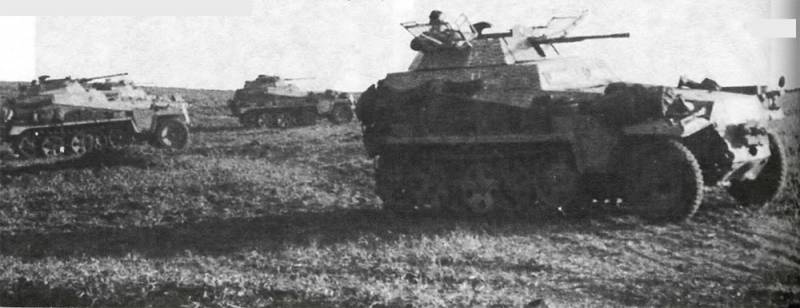
Connection equipped with Sd.Kfz.250 / 9 machines. Photo by Chamberlain P., Doyle H. "Complete German Reference tanks and self-propelled guns of World War II "
After a similar modernization with the installation of a new combat module, the reconnaissance vehicle retained some dimensions, while other parameters changed. The length remained at the level of 4,56 m, width - 1,95 m. Due to the installation of the new turret, the height of the vehicle increased to 2,16 m. . There was a possibility of acceleration to 6,02-55 km / h, the power reserve reached 60 km.
In March, the Wehrmacht 1942 ordered the production of the first batch of new combat reconnaissance vehicles in the number of 30 units. Soon, the first three samples were collected, which after factory testing went to the front. It was proposed to transfer this equipment to the troops for an inspection in a real war. The first conclusions about the front-line operation of the three Sd.Kfz.250 / 9 were made fairly quickly. Half-tracked vehicles quickly showed their advantages over wheeled armored vehicles, which determined their future.
It was decided to prepare and deploy a full-scale mass production of new reconnaissance vehicles on a better chassis. However, for some reason, the start of production was delayed. The first serial leichter Schützenpanzerwagen 2 cm was able to be assembled only by the middle of the 1943 year. Due to the beginning of the release of equipment with higher characteristics, it was decided to abandon the further assembly of Sd.Kfz.222 armored vehicles. The latest cars of this model were released in June 1943. The change of types of manufactured equipment led to a gradual transition of reconnaissance units to new armored vehicles.
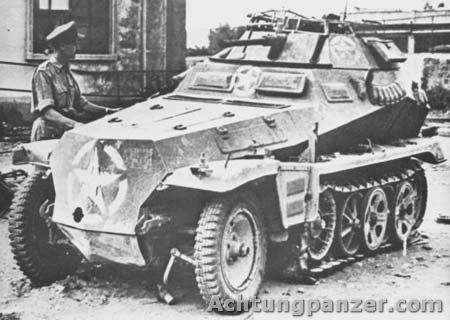
Trophy armored vehicle with new identification marks. Photo by Achtungpanzer.com
In its original form, Sd.Kfz.250 / 9 were produced until the fall of 1943. After that, a new version of this technique appeared, distinguished by a base chassis. Now, reconnaissance vehicles were built on the basis of Sd.Kfz.250 Neu armored personnel carriers with a simplified hull structure and a different power plant. Also, a new modification of the turret was soon introduced, featuring a simplified design of six armor plates. The composition of weapons, however, remained the same.
The release of combat reconnaissance vehicles continued until almost the very end of the war and the surrender of Germany. According to reports, 1943 units of such equipment were released during 324, and 1944 was also released in 318. During the first months of 1945, only 154 machines managed to be assembled. Most of this technology managed to go to the troops and participate in hostilities.
The leichter Schützenpanzerwagen 2 cm / Sd.Kfz.250 / 9 reconnaissance vehicle was created in accordance with the requirements of the Eastern Front. As a result, the vast majority of such equipment was sent to war with the Red Army. The operation of these machines was associated with both positive aspects and disadvantages. The relatively high permeability of the semi-tracked chassis made it possible to move along roads and rough terrain. Gun-gun armament allowed to protect against infantry or light equipment, and observation devices and a radio station provided a solution to the main tasks.
However, the reconnaissance units of the German army regularly suffered casualties. As a result, a significant number of reconnaissance vehicles did not survive until the end of the war. According to reports, of the nearly eight hundred Sd.Kfz.250 / 9 built by the spring 1945, just over half remained in the ranks. Part of this technology was soon destroyed or taken as trophies in the last battles of World War II in Europe.
After the capitulation of Germany and the end of the war, the need for the further exploitation of the existing reconnaissance vehicles disappeared. In addition, now their very existence was a reason for doubt. As a result, in the first post-war years almost all leichter Schützenpanzerwagen 2 cm were sent for breaking, since they no longer had any interest in terms of learning German experience or operating existing machines.
Recycling was avoided only by a few units of reconnaissance vehicles, which are now museum exhibits. According to reports, one of the samples of Sd.Kfz.250 / 9 is currently in the Kubinka Armored Museum. Another such car is available in the French Saumur. A few years ago it was reported that a new model of such equipment should appear by the efforts of American enthusiasts. The team of armored vehicles was planning to restore the rare technology, which at that time was a set of pretty rusted parts. All surviving samples were built on the basis of the “old” armored personnel carrier chassis.
The draft reconnaissance vehicle Sd.Kfz.250 / 9 or leichter Schützenpanzerwagen 2 cm can be considered as one of the most successful reworking options for a serial light armored personnel carrier. The task of the project was to create a new armored vehicle adapted to the conditions of the Eastern Front. This work was successfully completed, which led to the appearance of a sample with sufficiently high characteristics suitable for operation in the required conditions. The real result of the project was the construction of nearly eight hundred armored vehicles, which were operated with varying success in wartime conditions, and also gradually displaced the less successful equipment of the existing types from parts.
Based on:
http://achtungpanzer.com/
http://pro-tank.ru/
http://tanks-encyclopedia.com/
http://the.shadock.free.fr/
Chamberlain P., Doyle H. Complete reference book of German tanks and self-propelled guns of the Second World War. - M .: AST: Astrel, 2008.
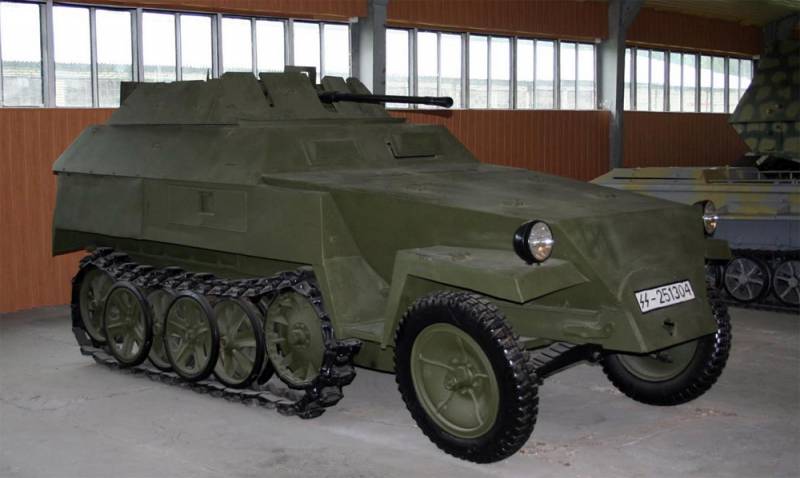
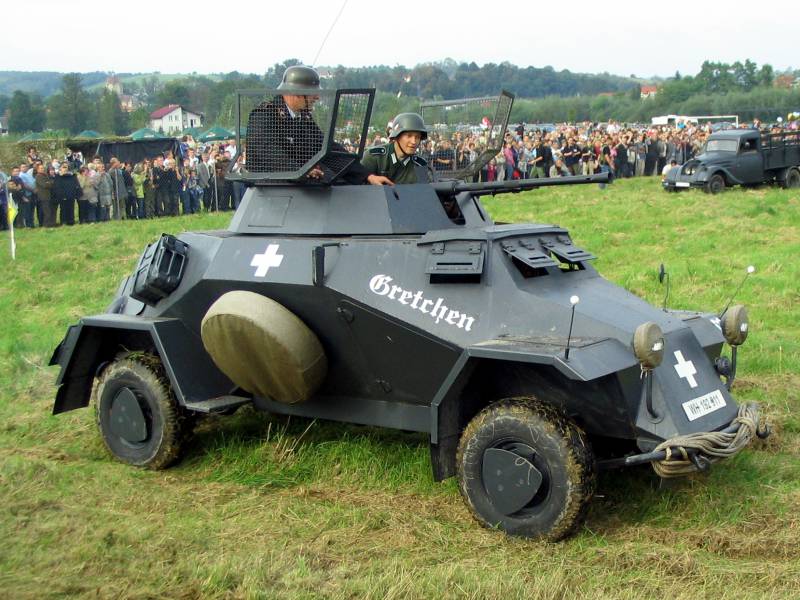
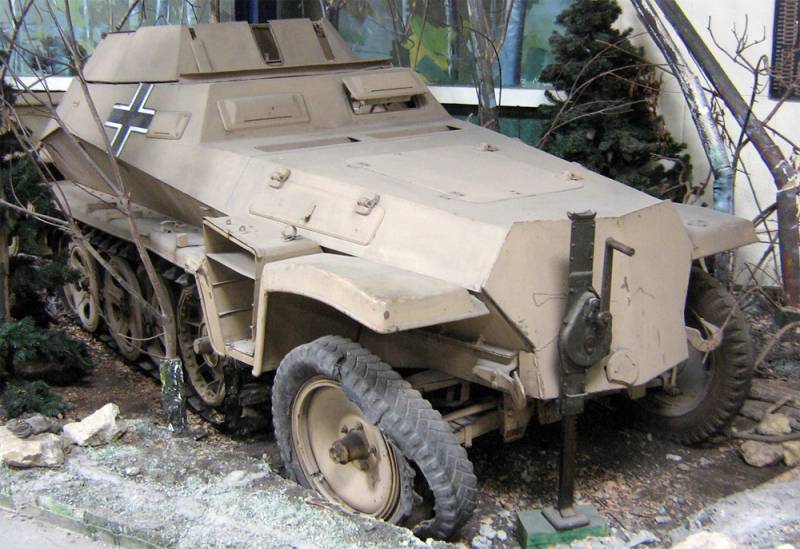
Information